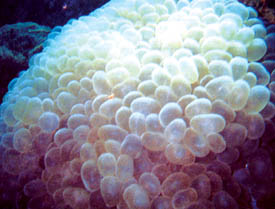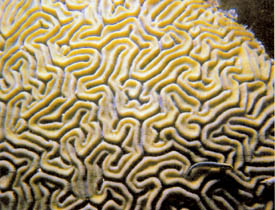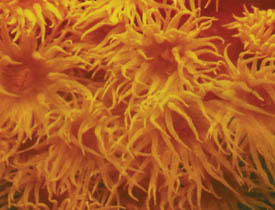|
dailynews |
|
|
|
|
|
OTHER LINKS |

|

|

|
Coral Reefs
A coral is a structure built by a polyp. A polyp is a small invertebrate animal that lives in the sea. It belongs to the same group of animals as Sea Anemones, Jellyfish and Corals. Most polyps live in large colonies. The soft body of a coral polyp is about the size of a pencil eraser. Corals breed by both sexual and asexual reproduction. The newborn coral larva resulting from fertilization of eggs and sperms is called a planula. It is only the size of the head of a pin and it floats in the sea till it finds something hard to latch onto and develop in to a polyp. Polyps also reproduce asexually by budding, where an identical polyp sprouts out of the polyp's side. Broken pieces of corals that land on a suitable substrate also may begin growing and produce a new colony.
Corals feed on particles and organisms like zooplankton in the water column. They use two methods of prey capture: They catch their food using the tentacles that they have round their mouths. These tentacles have poisonous stingers called nematocysts. Some corals will trap prey in sticky mucus on their tentacles and move the prey into the mouth. Most corals feed at night. However, an alga known as Zooxanthellae provides important sources of nutrition to reef building corals. Zooxanthellae are unicellular - i.e. body made of one cell -, yellow-brown algae, which live within the reef-building corals. Nutrients supplied in the form of photosynthetic products by the zooxanthellae make it possible for the corals to grow and reproduce quickly enough to create reefs. In turn, the coral provides protection and access to light for the zooxanthellae. Relationships like this in which both parties benefit are called symbiotic. Because of the need for light, corals containing zooxanthellae only live in ocean waters less than 100 meters deep. There are two types of corals, hard and soft. Hard corals have an internal, rock-like, chalky (calcium carbonate) skeleton that remains when they die and have six tentacles in the polyp. Soft corals have eight tentacles on their polyps. They are soft or leathery in texture and have limestone pieces embedded in the body instead of a solid skeleton. Huge colonies of hard corals form coral reefs. The corallite is the part of the skeleton deposited by one polyp. The calcium carbonate is secreted at the base of the polyps. The living coral colony is found to completely cover this hard, stony, branching calcium carbonate structure, which is continuously deposited by the living colony, making this structure bigger. When coral polyps die, another polyp, which latches itself on to this structure, will grow on top of the old one.
While corals form the reef structure, algae living in the reefs cement various corals together with compounds of calcium, other organisms such as tube worms and molluscs contribute to the reef by leaving behind their hard skeletons. A coral colony may consist of thousands of polyps. An entire colony, many meters in diameter, can start out as a single polyp. Coral reefs consist of many diverse species of corals. Many corals have different growth forms and shapes and come in many colours. Common names for corals refer to the shape of their colonies. There are orange cup corals. (Tubastrea coccinea) and golf ball corals (Favia fragum). They can also be meandroid in which corallites form a series within the same walls, as in the Pillar Coral species (Dendrogyra cylindrus). There are massive, staghorn or branching, plating, encrusting, columnar, corymbose and foliacious (leaf or vase-like). Coral reefs start out small and grow about half an inch a year, but if undisturbed by man they can grow to be quite large. The tan parts of the reefs that one observes are the shells of dead coral polyps and the colorful parts are the living reefs. Coral polyps construct many different types of reefs. The three basic types of coral reefs are fringing reefs, barrier reefs and atolls. Fringing reefs are coral reefs that grow in shallow waters and border the coast closely or are separated from it by a narrow stretch of water. Fringing reefs consist of several zones that are characterized by their depth, the structure of the reef, and its plant and animal communities. Barrier reefs are those that are separated from land by a lagoon. These reefs grow parallel to the coast and are large and continuous. The Great Barrier Reef off the northeast coast of Australia is 150 km wide and 2000 km long. The third type of reefs is the atolls. Coral Atolls are rings of coral that grow on top of old, sunken volcanoes in the ocean. They begin as fringe reefs surrounding a volcanic island; then, as the volcano sinks, the reef continues to grow, and eventually only the reef remains.
There are two types of atolls, deep sea atolls that rise from deep sea and those found on the continental shelf. Coral bleaching is the whitening of coral colonies due to the loss of symbiotic zooxanthellae from the tissues of polyps. This loss exposes the white calcium carbonate skeletons of the coral colony Reefs provide food and shelter to fish and invertebrates Sponges, such as Cliona, cause bioerosion in corals. Sponges inhabit corals for the purpose of protection from predators. Crustaceans, like crabs, shrimp, and lobsters, fish like Reef Sharks, groupers, clown fish, eels, parrotfish, snapper, and also scorpion fish, turtles, sea snakes, snails, and mollusks like octopuses, nautilus, and clams, are found in coral reef environments. Birds also feast on coral reef animals. Corals play a very important role in that they control the amount of carbon dioxide in the ocean water by trapping carbon dioxide in the limestone shell. In addition, coral reefs are very important because they provide a barrier between the ocean and the shore and protect the coasts from strong currents and waves. Coral reefs of Sri Lanka A total of 183 species of stony corals divided among 68 genera have been recorded from Sri Lanka. Almost 400 species of reef and reef-associated species have been identified during the reef surveys conducted by NARA. This is from a total of nearly 1000 known reef and reef-associated species. Sri Lankan reefs also support many species of invertebrates including commercially important species of spiny lobsters, shrimps and crabs and marine flora such as sea grasses and algae. Dolphins, whale sharks and sea turtles have also been sighted among inshore and offshore reefs.
The growth of coral reefs around Sri Lanka is influenced mainly by the monsoons, which have a major impact on the level of turbidity and fresh water input into the coastal waters. Only 2% of the shoreline of Sri Lanka has true coral reefs. Most fringing reefs are found on the south-western, southern and eastern coasts. In the south they are found at Hikkaduwa, Unawatuna and Weligama. In the eastern seaboard, they are found, in Trincomalee going up to Kuchchiveli (Pigeon Island). Well developed off shore coral reefs occur from Kalpitiya northwards to Mannar. Coral reefs around the Jaffna Peninsula are less developed and occur mainly around the coastal islands. There are Barrier reefs off Vakarai and Silvaturai on the east coast. They are the true coral habitats consisting of live coral as well as calcareous substances, sandstone and rocky habitats Only two coral reef areas have been afforded legal protection so far. The Hikkaduwa Marine Sanctuary is located in the southern province and is one of the most popular tourism sites in Sri Lanka. It is the first national marine sanctuary and was established in 1979. The Bar Reef, located west of the Kalpitiya Peninsula near Puttalam lagoon, was declared a marine sanctuary in 1992. Because many coral reef organisms can tolerate only a narrow range of environmental conditions, the slightest change in the reef environment may have detrimental effects on the health of entire coral colonies. These changes generally fall within two categories: natural disturbances and anthropogenic, or man made, disturbances. Because of the important ecological and economic roles that coral reef communities play, an understanding of the stresses and dangers to the reefs is necessary Most near shore reefs in Sri Lanka have been severely damaged due to human activities. The major causes are coral mining, destructive fishing methods, uncontrolled harvesting and pollution.
The increased amount of earth and sand, from land-clearing areas, that comes with run off carries large amounts of sediment. High levels of nutrients from agricultural areas or septic systems, as well as many pollutants such as petroleum products or insecticides are also detrimental to the reefs. It can be direct sedimentation onto the reef or an increase in the turbidity of the water due to eutrophication, which is a condition resulting from excess nutrients flowing into the water (e.g. Hikkaduwa). The water becomes green or brown, gives off bad odour and the resulting decrease in the amounts of light reaching corals will destroy them. Water treatment plants and large power plants are the cause of much damage to coral reefs by altering water temperatures by their discharge of extremely hot water into the coastal waters. Coral reefs also receive much damage from both commercial and private vessels. Anchor damage to coral reefs is also common during fishing operations and when boats are anchored within reef lagoons. The leakage of fuels into the water and the occurrences of spills by large tankers are extremely damaging to local corals. It has also been found that the anti-fouling bottom paints used by many boats contribute to the formation of toxic concentrations of Tributyl tin (TBT) and several other chemical compounds, which may be harmful to corals or other coral species. Wastewater and bilge water are dumped overboard from ships. As a result of these, coral reef lagoon areas of Hikkaduwa, Weligama and Negombo lagoon have become highly polluted. Highly efficient fishing techniques, introduced recently, such as the bottom-set nets to catch spiny lobsters and reef fish cause, severe damage to coral reefs. Blast fishing using explosives is also commonly practiced in many parts of the country, being most prevalent in the southern coastal waters in the Galle District.
In some areas fish traps with small mesh diameters are used to catch even the small juvenile fish. Not only do these practices kill all fish in the affected areas but they also severely damage the corals. Muro-ami netting pounds the reefs with weighed bags to scare fish out of crevices. Trawling also directly damages the corals. These methods are generally non-selective and large numbers of other species, along with undersized target species, are swept up in nets or are killed by poisons or explosives in the process. Major damage is caused by the extraction of living and dead coral for the lime industry, which is subjected to some degree of control now, especially after tsunami. More damage is caused by the over harvesting of exotic reef resources such as ornamental fish for export and for tourism related activities. There are between 200 and 300 marine species of fish and invertebrates that are being exported by the aquarium trade With regard to fisheries export products, ornamental fish exports are rated as the third highest in volume and value, after prawns and lobsters. Due to over fishing, reef fish populations have been greatly reduced in some areas. The removal of large numbers of reef fish has caused the loss of a natural balance in coral reef ecosystems and has allowed more competitive organisms, such as algae, which were once controlled by large fish populations, to become dominant on the reefs. Corals are also very popular as decorations. This is very damaging because a large amount of the healthiest corals are selected for curio shops by commercial collectors Due to their beauty coral reefs brings much income from tourism. The Hikkaduwa Marine Sanctuary is one of the places which attracts tourists most. Hikkaduwa's reefs are being gradually worn down. Snorkeling on coral reefs causes damage to corals with branching species being the most susceptible. Snorkelers and divers often stand on reefs walk over corals in the shallows. Reef working at low tide is very popular among tourists. This causes lot of damage to corals in areas with highly developed cover of fragile reefs. A status report published by NARA assessed the degree of damage and threats to various coral reefs of Sri Lanka. According to the report, in the Bar Reef Marine Sanctuary the shallow the coral areas are partially damaged while the deep coral areas are in good condition. The Crown of Thorns Starfish, destructive fishing, uncontrolled harvesting and boat anchors, cause the damage. The Chilaw corals are partially damaged owing to destructive fishing and uncontrolled harvesting. Negombo reefs are mostly in good condition though some damage is evident in the inshore reefs. The inshore reefs from Ambalangoda to Hikkaduwa are degraded while the offshore reefs are in relatively good condition The Hikkaduwa Marine Sanctuary is partially degraded owing to sedimentation, boat anchoring, reef trampling, pollution, use of glass bottom boats and increase of Halimeda, which is a large green algae that is threatening several other reefs as well including Pasikuda. It is a calcareous algae in that it deposits calcium carbonate in its tissues. When the algae die, it leaves a limestone 'skeleton' behind. Galle including the Rumasssala reef, Unawatuna and Weligama are under different degrees of degradation while Polhena, in Matara, is heavily degraded due to the seasoning of coconut husks. The Great and Little Basses are relatively undegraded but uncontrolled harvesting takes place. There are several natural disturbances, which cause significant damage to coral reefs. The most recognised of these events are hurricanes or typhoons, which bring large and powerful waves to the tropics. These storm waves cause large corals to break apart and scatter fragments about the reefs. In addition, these storms generally bring heavy rain, which increases runoff and sedimentation. Tsunamis are another natural force that damages coral reefs. The impact of the tsunami in 2004 was highly varied, ranging from almost unaffected to extreme damage. Almost total destruction of a reef was seen at Dutch Bay off Trincomalee town. Most damage observed was mechanical, with breakage of fragile corals, notably Acropora and Montipora spp., and larger massive colonies toppling over. There was also damage caused by rubble, which dated back to a mass coral mortality in 1998, triggered by rising sea temperature. The impact on fish populations were most likely the loss of fish habitat. Some smothering has been observed. Severe damage on the coast was observed where coral mining in the sea has been rampant. Currently, specific laws relating to corals are included in the Fauna and Flora Protection Act, the Coastal Conservation Act, the Marine Pollution Prevention Act and the Fisheries and Aquatic Resources Act. The provisions of the Customs Ordinance relating to export of prohibited goods apply by extension. In relation to pollution in general, particularly water pollution, the National Environment Act may be cited as well. Pictures Courtesy: IUCN |
 RAIN
FORESTS OF THE SEA: Coral reefs are called the rain forests of the sea
owing to their diverse and productive nature. They are found in the
warm, clear, shallow waters of tropical oceans worldwide.
RAIN
FORESTS OF THE SEA: Coral reefs are called the rain forests of the sea
owing to their diverse and productive nature. They are found in the
warm, clear, shallow waters of tropical oceans worldwide. 













